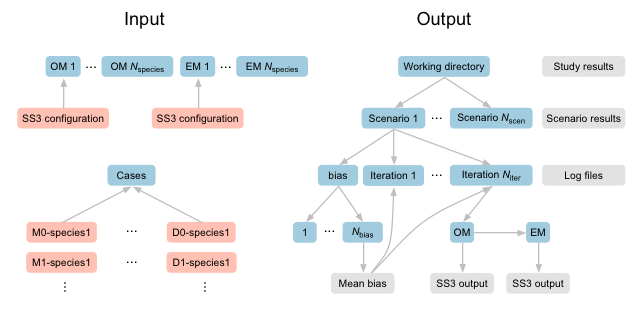ss3sim is an R package that facilitates flexible, rapid, and reproducible fisheries stock assessment simulation testing with the widely-used Stock Synthesis 3 (SS3) statistical age-structured stock assessment framework.
- Installing the ss3sim R package
- The ss3sim simulation setup
- How ss3sim works
- Example output from an ss3sim simulation
- Papers published using ss3sim
- Citing ss3sim
Install the CRAN version of ss3sim with:
install.packages("ss3sim")Or, install the development version from GitHub:
# install.packages("devtools")
devtools::install_github("ss3sim/ss3sim") # without vignettes (faster)
devtools::install_github("ss3sim/ss3sim", build_vignettes = TRUE) # with vignettesIf you would like to run simulations in parallel, then also run:
install.packages(c("doParallel", "foreach"))You can then load ss3sim with:
library("ss3sim")You can read the help files with:
?ss3simand access the vignettes for reproducible examples of ss3sim simulations with:
browseVignettes("ss3sim")ss3sim requires a specific version of the SS3 binary/executable. With the permission of Rick Methot, we have hosted those files here: https://www.dropbox.com/sh/zg0sec6j20sfyyz/AACQiuk787qW882U2euVKoPna. (These versions are compatible with the GitHub development version of ss3sim; see this link for the executables compatible with the stable CRAN version.)
These files need to be placed in your operating system's path so ss3sim can find the software. See the Introduction vignette with vignette("introduction", "ss3sim").
In addition to the vignette, we published a paper in PLOS ONE, which describes the package.
An ss3sim simulation requires three types of input:
- a base model of the underlying truth (an SS3 operating model)
- a base model of how you will assess that truth (an SS3 estimation model),
- a set of cases that deviate from these base models that you want to compare (configuration arguments provided as plain-text control files).
You can find examples of these SS3 operating and estimation models within the package data. Plain-text case files for some current simulation projects run by the developers of the package are also available along with the case files for the examples used in the paper and vignette.
An illustration of the input and output file and folder structure.
ss3sim works by converting simulation arguments (e.g. a given natural mortality trajectory) into manipulations of SS3 configuration files. It takes care of running the operating and estimation models as well as making these manipulations at the appropriate stage in the simulation.
ss3sim functions are divided into three types:
-
changeandsamplefunctions that manipulate SS configuration files. These manipulations generate an underlying "truth" (operating models) and control our assessment of those models (estimation models). -
runfunctions that conduct simulations. These functions generate a folder structure, call manipulation functions, run SS3 as needed, and save the output. -
getfunctions for synthesizing the output.
Example output from an ss3sim simulation. This example shows a crossed simulation in which we considered (1) the effect of fixing natural mortality (M) at its true value (0.2; case E0) or estimating M (case E1) and (2) the effect of high survey effort (sigma_survey = 0.1; case D0) or low survey effort (sigma_survey = 0.4; case D1). Upper panels (blue) show time series of relative error in spawning stock biomass (SSB). Lower panels (grey) show the distribution of relative error across four scalar variables: depletion, M, SSB at maximum sustainable yield (SSB_MSY), and fishing mortality (F) in the terminal year. We show the values across simulation iterations with dots and the distributions with beanplots (kernel density smoothers).
Ono, K., R. Licandeo, M.L. Muradian, C.J. Cunningham, S.C. Anderson, F. Hurtado-Ferro, K.F. Johnson, C.R. McGilliard, C.C. Monnahan, C.S. Szuwalski, J.L. Valero, K.A. Vert-pre, A.R. Whitten, A.E. Punt. 2014. The importance of length and age composition data in statistical catch-at-age models for marine species. ICES Journal of Marine Science. In press. http://doi.org/10.1093/icesjms/fsu007 (PDF).
Anderson, S.C., C.C. Monnahan, K.F. Johnson, K. Ono, J.L. Valero. ss3sim: An R package for fisheries stock assessment simulation with Stock Synthesis. PLOS ONE. 9(4): e92725. http://doi.org/10.1371/journal.pone.0092725 (PDF).
Johnson, K.F., C.C. Monnahan, C.R. McGilliard, K.A. Vert-pre, S.C. Anderson, C.J. Cunningham, F. Hurtado-Ferro, R.R. Licandeo, M.L. Muradian, K. Ono, C.S. Szuwalski, J.L. Valero, A.R. Whitten, A.E. Punt. 2015. Time-varying natural mortality in fisheries stock assessment models: identifying a default approach. 2015. ICES Journal of Marine Science 72 (1): 137-150 doi:10.1093/icesjms/fsu055. (PDF; code repository).
Hurtado-Ferro, F., C.S. Szuwalski, J.L. Valero, S.C. Anderson, C.J. Cunningham, K.F. Johnson, R.R. Licandeo, C.R. McGilliard, C.C. Monahan, M.L. Muradian, K. Ono, K.A. Vert-Pre, A.R. Whitten, A.E. Punt. 2015. Looking in the rear-view mirror: bias and retrospective patterns in integrated, age-structured stock assessment models. ICES Journal of Marine Science. 72 (1): 99-110 doi:10.1093/icesjms/fsu198.
If you use ss3sim in a publication, please cite ss3sim as shown by citation("ss3sim"):
Anderson, SC, Monnahan, CC, Johnson, KF, Ono, K, Valero, JL, Cunningham, CJ, Hurtado-Ferro, F, Licandeo, R, McGilliard, CR, Szuwalski, CS, Vert-pre, KA, and Whitten, AR (2014). ss3sim: Fisheries stock assessment simulation testing with Stock Synthesis. R package version 0.8.2.
Anderson, SC, Monnahan, CC, Johnson, KF, Ono, K, and Valero, JL (2014). ss3sim: An R package for fisheries stock assessment simulation with Stock Synthesis. PLOS ONE. 9(4): e92725. DOI: 10.1371/journal.pone.0092725.
@Manual{,
title = {ss3sim: Fisheries stock assessment simulation with {Stock Synthesis}},
author = {Sean C. Anderson and Cole C. Monnahan and Kelli F. Johnson and Kotaro Ono and Juan L. Valero and Curry J. Cunningham and Felipe Hurtado-Ferro and Roberto Licandeo and Carey R. McGilliard and Cody S. Szuwalski and Katyana A. Vert-pre and Athol R. Whitten},
year = {2014},
note = {R package version 0.8.2},
}
@Article{,
title = {ss3sim: An {R} package for fisheries stock assessment simulation with {Stock Synthesis}},
author = {Sean C. Anderson and Cole C. Monnahan and Kelli F. Johnson and Kotaro Ono and Juan L. Valero},
year = {2014},
journal = {PLOS ONE},
volume = {9},
number = {4},
pages = {e92725},
doi = {10.1371/journal.pone.0092725},
}


